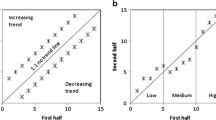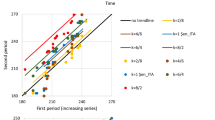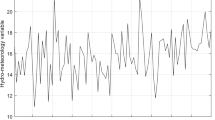Abstract
Hydro-climatological time series might embed characteristics of past changes concerning climate variability in terms of shifts, cyclic fluctuations, and more significantly in the form of trends. Identification of such features from the available records is one of the prime tasks of hydrologists, climatologists, applied statisticians, or experts in related topics. Although there are different trend identification and significance tests in the literature, they require restrictive assumptions, which may not be existent in the structure of hydro-climatological time series. In this paper, a method is suggested with statistical significance test for trend identification in an innovative manner. This method has non-parametric basis without any restrictive assumption, and its application is rather simple with the concept of sub-series comparisons that are extracted from the main time series. The method provides privilege for selection of sub-temporal half periods for the comparison and, finally, generates trend on objective and quantitative manners. The necessary statistical equations are derived for innovative trend identification and statistical significance test application. The application of the proposed methodology is suggested for three time series from different parts of the world including Southern New Jersey annual temperature, Danube River annual discharge, and Tigris River Diyarbakir meteorology station annual total rainfall records. Each record has significant trend with increasing type in the New Jersey case, whereas in other two cases, decreasing trends exist.






Similar content being viewed by others
References
Cailas MD, Cavadias G, Gehr R (1986) Application of a non-parametric approach for monitoring and detecting trends in water quality data of the St. Lawrence River. Water Pollut Res J Can 21(2):153–167
Demaree GR, Nicolis C (1990) Onset of Sahelian drought viewed as a fluctuation-induced transition. Q J R Meteorol Soc 116:221–238
Douglas EM, Vogel RM, Kroll CN (2000) Trends in floods and low flows in the United States: impact of spatial correlation. J Hydrol 240:90–105
Fatichi S, Ivanov VY, Caporali E (2013) Assessment of a stochastic downscaling methodology in generating an ensemble of hourly future climate time series. Clim Dyn 40:1841–1861
Gan TY (1998) Hydro-climatic trends and possible climatic warming in the Canadian prairies. Water Resour Res 34(11):3009–3015
Hamilton JP, Whitelaw GS, Fenech A (2001) Mean annual temperature and annual precipitation trends at Canadian biosphere reserves. Environ Monit Assess 67:239–275
Hipel KW, McLeod AI, Weiler RR (1988) Data analysis of water quality time series in Lake Erie. Water Resour Bull 24(3):533–544
Hirsch RM, Slack JR (1984) A nonparametric trend test for seasonal data with serial dependence. Water Resour Res 20(1):727–732
Hirsch RM, Slack JR, Smith RA (1982) Techniques of trend analysis for monthly water quality analysis. Water Resour Res 18(1):107–121
IPCC (2007) Working group II contribution to the intergovernmental panel on climate change fourth assessment report climate change 2007: climate change impacts, adaptation and vulnerability. World Meteorological Organization, WMO, Switzerland, p 9–10
Kalra A, Piechota TC, Davies R, Tootle GA (2008) Changes in U.S. streamflow and western U.S. snowpack. J Hydrol Eng 13:156–163
Kendall MG (1975) Rank correlation methods. Oxford University Press, New York
Lins HF, Slack JR (1999) Streamflow trends in the United States. Geophys Res Lett 26(2):227–230
Maass A, Hufschmidt MM, Dorfman R, Thomas HA Jr, Marglin SA, Fair GM (1962) Design of water resources systems. Harvard University Press, Cambridge, Mass
Mann HB (1945) Nonparametric tests against trend. Econometrica 13:245–259
Milly PCD, Betancourt J, Falkenmark M, Hirsch RM, Kundzewicz ZW, Lettenmaier DP, Stouffer RJ (2008) Stationarity is dead: Whither water management? Science 319(5863):573–574
Sen PK (1978) Estimates of the regression coefficient based on Kendall’s tau. J Am Stat Assoc 63:1379–1389
Şen Z (2012) Innovative trend analysis methodology. J Hydrol Eng 17(9):1042–1046
Şen Z (2014) Trend identification simulation and application. J Hydrol Eng 19(3):635–642
Taylor CH, Loftis JC (1989) Testing for trend in lake and groundwater quality time series. Water Resour Bull 25(4):715–726
van Belle VG, Hughes JP (1984) Nonparametric tests for trends in water quality. Water Resour Res 20(1):127–136
von Storch H (1995) Misuses of statistical analysis in climate research. In: Storch HV, Navarra A (eds) Analysis of climate variability: applications of statistical techniques. Springer, New York, pp 11–26
Yu YS, Zou S, Whittemore D (1993) Non-parametric trend analysis of water quality data of river in Kansas. J Hydrol 150:61–80
Author information
Authors and Affiliations
Corresponding author
Rights and permissions
About this article
Cite this article
Şen, Z. Innovative trend significance test and applications. Theor Appl Climatol 127, 939–947 (2017). https://doi.org/10.1007/s00704-015-1681-x
Received:
Accepted:
Published:
Issue Date:
DOI: https://doi.org/10.1007/s00704-015-1681-x




